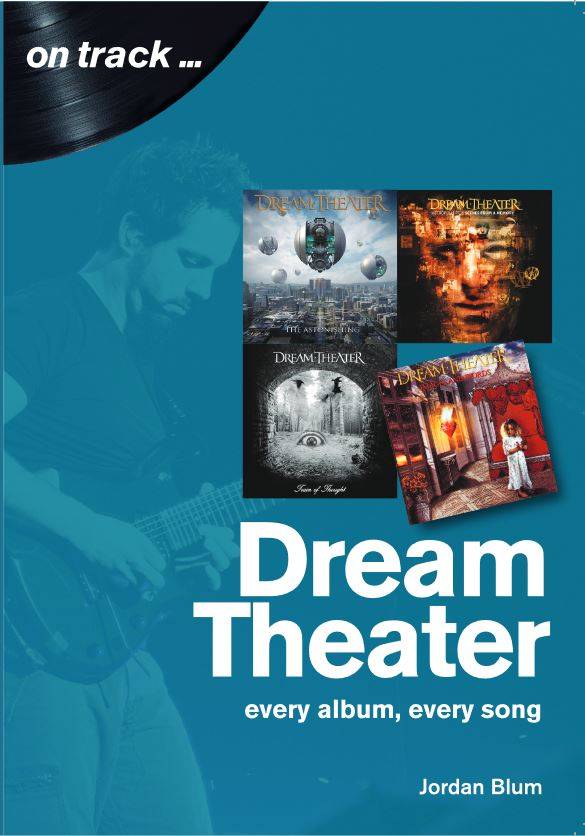Ever since its launch a couple of years ago, Sonicbond Publishing has published books in a series called On Track, where the discographies of artists and bands from Elton John through QUEEN to JUDAS PRIEST get analyzed album-by-album and song-by-song. The latest addition is Dream Theater: Every Album, Every Song by Jordan Blum. Blum is a familiar name to me, as I’ve read articles he’s written about many of my prog favorites, including RUSH, OPETH, and RIVERSIDE, so I was curious to read what he would have to say about the biggest name in progressive metal in a full-length book.

As the title implies, the book goes through every DREAM THEATER album and each chapter includes an analysis of every track, as well as a look into the bonus content. In addition to the albums, there’s a chapter offering a run-through of the live releases, official bootlegs, the “Greatest Hit (…and 21 Other Pretty Cool Songs)” compilation from 2008, and appearances on releases featuring various artists. Blum does a great job detailing the band’s history and the circumstances in which each album was made, using Rich Wilson‘s official DREAM THEATER biography, Lifting Shadows (2007, revised ed. 2013), as the main source, although there are a few errors here and there – for example, ex-vocalist Charlie Dominici didn’t join the band on stage for the 15th anniversary performance of “When Dream and Day Unite” (1989), but for the encore. Blum also gives room for contemporary reactions to every record by referencing the reviews they got from the music press upon their release. However, for the sake of clarity, it would’ve been good to include footnotes to make it clearer which interview quote or piece of information is from which source, as now there’s just a bibliography at the end.
Blum‘s song analyses are rather thorough, discussing the lyrical meanings and breaking down the different segments of the songs, but without using a lot of technical language related to music theory, which may make them a little more accessible for those who don’t play any instrument. Once again, there are a few errors (the intro of “The Glass Prison” is played on bass, not guitar!) and his breakdowns of some of the songs he’s not too keen on are a little briefer than the others, but his general enthusiasm for the music shines through in the text – sometimes in the form of puns related to the albums or songs – and makes the book worth checking out. Music is subjective and evokes all kinds of opinions, so if yours are similar to mine, you may raise an eyebrow when Blum describes “A Nightmare to Remember” – which features ex-drummer Mike Portnoy‘s notorious attempt at growling – as “one of the greatest tracks DREAM THEATER ever cut” and the utterly gorgeous “Surrounded” as “a comparatively weak offering overall,” although we also share a love for “Space-Dye Vest.” I also hold the Kevin Moore era in higher regard than Blum does, but I do agree with his assessment of “A Dramatic Turn of Events” (2011) – current drummer Mike Mangini‘s debut with the group – as a late-career highlight.
Blum makes plenty of clever observations about the band and the songs that I hadn’t really thought of earlier, such as the QUEENSRYCHE influence on “The Killing Hand,” which I can now hear as well. Another one is that, while the 23-minute title-track of 1995’s “A Change of Seasons” EP would pave the way for the band’s later epics, the live cover selections foreshadowed the full album covers that the group would perform in the early to mid-2000s, such as METALLICA‘s “Master of Puppets” and PINK FLOYD‘s “The Dark Side of the Moon.” Blum also appropriately notes that DREAM THEATER are in a bit of a no-win situation due to their long history: if they stick to basics, as they did on 2013’s self-titled album, they get criticized for being too formulaic, but if they try something different, as on “The Astonishing” (2016), they get accusations of straying too far from the classic sound.
Although some tidbits of information regarding the songs were new to me, for a person like myself who knows every DREAM THEATER song and already owns a copy of “Lifting Shadows,” the most intriguing part of the reading experience was comparing how Blum‘s opinions on the catalog differ from mine. Nitpickers may gripe that technically speaking the book doesn’t feature every single DREAM THEATER song, due to the lack of analyses of demo-only tracks, such as the ones that didn’t make it onto “Falling into Infinity” (1997), but I suppose the line had to be drawn somewhere to avoid the inclusion of things such as all the 10-second novelty tracks from the 2003 official bootleg release of “The Majesty Demos.” For a total DREAM THEATER newbie, it’d probably be wiser to get acquainted with at least some of the material and let the music speak for itself beforehand, because otherwise I can imagine a book about an unfamiliar band’s discography being a little challenging, but I do believe Dream Theater: Every Album, Every Song can potentially be a useful read for non-diehard DREAM THEATER fans, who haven’t heard all the records and don’t know the background stories behind them yet.
Bonus:
At the end of the book, Blum reveals his own “ultimate DREAM THEATER playlist,” including what he considers “the most essential and emblematic DREAM THEATER tracks,” as well as his personal album ranking. Since he says he’s interested to hear how the readers see DREAM THEATER‘s discography, here are the albums in my order of preference:
1. Awake
2. Images and Words
3. Six Degrees of Inner Turbulence
4. When Dream and Day Unite
5. A Dramatic Turn of Events
6. Metropolis Pt. 2: Scenes from a Memory
7. Train of Thought
8. Falling into Infinity
9. Black Clouds & Silver Linings
10. Octavarium
11. Distance over Time
12. Dream Theater
13. The Astonishing
14. Systematic Chaos
Blum also encourages the readers to share their own DREAM THEATER playlists, so here’s a collection of songs that I would recommend to anyone who wants to find out what the band is all about, including my favorites from most albums, as well as a few more easily digestible singles, such as the greatest hit, “Pull Me Under,” or otherwise representative tracks:
Written by Wille Karttuen
Musicalypse, 2020
OV: 566
Recent posts
[recent_post_carousel design=”design-1″]




